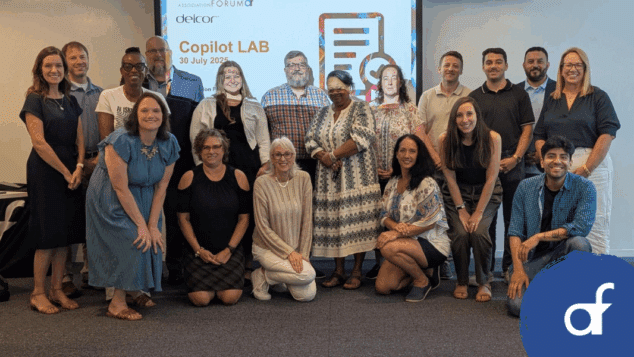A Detailed Look at How Associations Are Navigating the New Meeting Frontier

There’s a reason that the old association playbook for events — get everyone in a room and serve up great content with networking opportunities — stayed the same for so long. Quite simply, it worked. Then COVID-19 blew up the playbook. Since, it’s been a time of innovation and trial and error for planning and hosting events.
“An event now is completely different than before,” says Kimberly Gishler, executive director of the Corporate Event Marketing Association (CEMA). “You have to be agile and nimble all the time. You read the signals of what’s going on in the moment and make decisions based on that.”
Things only got trickier in 2021. The Delta variant and inconsistent vaccination rates tossed cold water on a major return to in-person events. At the same time, many are pandemic-weary and ready for more face-to-face interaction. Such conditions have left associations to navigate the murky waters of mixed vaccination statuses, varying contact comfort levels and higher expectations for virtual events.
But if there’s anything the pandemic has taught, it’s that associations need to be adaptable. Some organizations have responded with thoughtful in-person events, while others blazed a digital path, cutting their teeth with all things tech. All of these meetings look a bit different than in years past, but success hinges on plunging into the messiness of this new reality.
“I hear, ‘There is no going back’ a lot,” says Mary Byers, an association adviser and author of Race for Relevance: 5 Radical Changes for Associations. “When we hear that, we need to proactively replace those words with a go-forward strategy.”
Here’s how associations are venturing out into this new frontier of events, including navigating safety, technology and content needs.
The New Normal
In 2022 and beyond, events will continue to provide the option to attend in person and virtually, with varying options for engagement depending on where the attendee lives, says Jason Enany, head of operations for New York-based virtual and hybrid event and meeting company Convene. “I expect that amenities will be a major consideration to entice members to return for events — from wellness facilities (skincare, massage, nutrition and exercise) to premium food and beverage offerings. Organizations can utilize quality-of-life benefits to make events stand out going forward,” Enany says.
Meanwhile, virtual elements of events, whether in-person or not, are expected to not just stick around but also improve. Early trends include offering remote audience chats, virtual breakout sessions and AI-powered networking. “Virtual meetings have already become more interactive, and as they continue to evolve, they’ll become more like talk shows with guests, videos, music, etc.,” Byers says. The format, she says, with small in-person audiences and a greater portion watching remotely, “has been a staple of the networks for decades because it works. Associations should consider adapting the concept as they look for unique and proven ways to meet the needs of both the in-person and online audiences.”
Many hotels and convention centers have already invested millions of dollars to transform facilities for this enhanced reality. America’s Center in St. Louis, for example, unveiled a new StreamStage that provides high-volume internet bandwidth for live streaming, an HD camera and a studio backdrop.
“Over time, the difference between attending in person or virtually will become less prominent thanks to advances in technology,” Enany says.
Hybrid Heats Up
Hybrid, hybrid, hybrid: The word hasn’t been said this often since the Toyota Prius debuted. But just as hybrid teams are considered the future of work, many association professionals think hybrid events will dominate the event landscape moving forward. Technology, naturally, will help lead the way. Sixty percent of association event planners say they will host a hybrid event in 2021-2022. According to 2021 research from EventsForce, 19% of associations have attracted new members as a result of reaching out to a wider online audience because of expanded digital access. But a lack of in-person events has been tough on associations, too. In fact, 64% of respondents in the EventsForce survey said they’ve experienced revenue loss from events, and 32% have seen a drop in membership.
Overall, associations have seen real benefits from offering hybrid events:
- 90% expanded their audience reach
- 41% saw more engagement from existing members
- 31% got more valuable data from events
- 29% saw new revenue opportunities from on-demand content
What hybrid means can vary widely. For some, it’s simply posting a recorded version of a live event or a program. For others, it’s much more complex — think a blend of in-person offerings with interactive virtual elements for members who can’t or don’t want to attend in person. For the associations that are really diving into this realm, that means creating “events that work with chat rooms, multimedia, live streaming,” Gishler says. “You have to change your mindset and think about how you will engage each audience.”
But, to be sure, having some kind of virtual event element is a must for all associations these days, and it’s something that Byers says won’t disappear even after the pandemic is under control. “Pre-pandemic, everyone was moving really slowly toward digital-first. That’s been transformed almost overnight,” she says.
How associations approach hybrid events — or whether they offer them at all — will largely depend on the association’s size, budget and opinions of its members. Sheri Mead, principal of Chicago meeting management consortium Mead & Co., has seen a distinct split between her smaller and larger association clients.
“The larger associations I work with have been on a ‘stop, go, go, stop’ continuum, and many have ended up producing smaller, hybrid programs,” she says. “My smaller associations have been more conservative. They haven’t produced any in-person events to date and don’t plan on it until at least April 2022.”
Many of the smaller associations she works with have fully embraced virtual-only options for board meetings and educational programs. She expects that, in the near term, most will stick to all-virtual and then branch out to in-person events, but few small associations will host hybrid events. “They don’t have the budget for it or see the perceived benefit of producing hybrid events,” she says.
It’s true that offering a robust digital experience — especially for a large live event — can be costly and time-consuming. In many ways, it’s like putting on two separate events. But many associations have done just that or are planning to do so for annual meetings. It makes sense at a time when many people are still very reluctant to travel or interact in large groups.
“In-person is the No. 1 choice of our members, but hybrid will never go away for safety and travel concerns,” Gishler says. “You can reach more people with a digital event. The challenge is to make it relevant and valuable.”
The In-person Eventscape
While planning an association event is never a simple task, tossing a pandemic into the mix has certainly complicated matters. Along with all of the typical event-planning struggles, associations must also consider a host of new questions: Do you offer on-site COVID-19 testing? What about wristbands to show comfort level? How much space should be provided for people to socially distance and feel comfortable? What happens if someone tests positive?
And while people are more accustomed to “living with” COVID-19 and the safety measures that come with it, there is also a lot of uncertainty around safety protocols. Some states have mask mandates, while others have bans on mask mandates. Some cities have indoor capacity restrictions, while others don’t. Rules can vary city to city or venue to venue.
“It’s the Wild West as far as events are concerned,” Byers says. “Different states have different requirements, and these change frequently. We need to be upfront that in-person meetings aren’t what they used to be, so that attendees aren’t disappointed.”
Clear and careful communication is key going forward — and an approach that’s been a top priority for associations that have already hosted in-person events or are planning them in the near future. Constantly shifting guidelines and COVID-19 case counts demand it. That’s been the case for the American Association for Anatomy, which is planning a large-scale, in-person annual meeting in the spring of 2022, says Shawn Boynes, executive director, American Association for Anatomy.
“There’s been so much uncertainty and rapid changes,” Boynes says. “We may have to wait until the first quarter to define many safety precautions.”
While many details might be up in the air in the future, many associations already know some of the areas they must tackle to host a successful and safe in-person event.
Vaccination requirements and screening
There’s no clear verdict on whether members should be required to be vaccinated to attend an event. A common path — which CEMA used for its in-person summit in July in Phoenix — is to require proof of vaccination or a negative COVID test to enter the event. CEMA worked with the company Clear to establish attendees’ vaccination statuses, Gishler says. “We also provided free on-site COVID testing for people who didn’t have their Clear credentials established,” she says. Several hotels, such as Marriott and Hilton, have partnered with healthcare groups to offer advance or on-site COVID-19 testing.
If you’re planning on requiring vaccination to attend, an expectation that will probably increase, “Make sure you’re giving people plenty of time to comply if proof of vaccination is required,” Byers says.
Color-coded comfort levels
In a pre-COVID world, handshakes — and even hugs — were often the norm at organization events. Now, there’s an awkward forward-and-backward-lean routine that people go through as they decide how to greet each other. Some organizations have removed the guesswork by offering color-coded badges, bracelets or lanyards. These badges let others know if someone is open to handshakes or hugs (green), is only up for conversation and elbow bumping (yellow) or prefers to keep a distance from other event attendees (red).
CEMA used color-coded lanyards at its summit, and they were a success, Gishler says. “We knew people had to feel safe. We had the best feedback we’ve ever had and felt we did the right thing to take these extra precautions,” she says.
Eating and socializing
“Buffet-style meals are off the metaphorical table,” says Enany. Pre-packaged meals or plated meals are now the norm, and tables that once sat eight or 10 people are now being set for four. At the same time, some event organizers are also enticing attendees by offering premium food and beverages, Enany says.
Many event organizers and venues are also looking at the outdoors with new eyes. (See pg. 20 for a full breakdown of running successful outdoor events.) If the weather permits, your event attendees will probably appreciate a chance to eat or socialize outdoors. Just be prepared that you might find it harder than usual to get them to stop socializing.
“People are excited to be together again and have that energy exchange with one another,” Gishler says.
The Keys to Virtual Events
Pre-COVID-19, the digital side of an event was often treated as an afterthought. And they usually weren’t very exciting, Byers says.
“Virtual was considered less desirable mostly because so many were audio with slides or a talking head,” Byers says. “But now that we’ve seen how they increase reach and save attendees both time and money, they are no longer lesser options.”
The tricky part is tailoring the material to a virtual audience, which requires a different approach than a live one. For virtual-only events, the approach is simpler since only one audience needs to be considered. For some of Mead’s clients, that has meant creating education-based webinars that have put some of the associations’ younger members front and center on camera.
“It’s been a great opportunity for these younger members. They’ve been able to move up in the organization without having to travel,” she says.
The digital portion of an in-person event, especially if it includes live elements, is much more complicated. In fact, 59% of association event planners find hybrid events to be complex and time-consuming to manage.
With that in mind, some associations are hiring third-party companies to help them manage the virtual part of an event or are working with venues that provide staff to help. Here’s what else to consider when planning a virtual event.
Make a content plan
First, you need to consider what kind of virtual content you will offer, when you will offer it and in what format. For example, will you livestream the in-person event or only offer pre-recorded content? What kind of interaction (polls, breakout rooms) will you have with your virtual audience, and will time zones be a factor? “To create the best virtual experience, you have to consider the production factor,” Boynes says. “How do you pull together something cohesive that gives the virtual audience a similar experience to the in-person audience? What keeps them glued to the session?”
Don’t forget to change up your marketing approach, too. Unlike an in-person event, virtual events are easy to skip or forget entirely. For that reason, be sure to ping your registered attendants by email and social media channels with event reminders. Play up the bonuses of taking part in the event, such as a chance to network, listen to top-notch speakers or experience a sense of community.
Keep it short and engaging
Don’t expect the same attention span from your virtual attendees as you would your in-person ones, Boynes says. Also consider the kind of environments where your virtual participants will be watching. “Many people are still working from home, have children and other things going on,” he says. “It’s easy to be distracted and step away.”
With that in mind, you might want to keep your digital content shorter and snappier. CEMA, for example, learned from its members that 90 minutes was the maximum amount of digital content they could take in at one time, Gishler says. Due to that, CEMA decided to livestream the keynote and townhall portions of its Summit and offered the rest on demand.
Byers expects that many organizations will stretch out their digital content so it lasts much longer — weeks or even months — beyond the event itself. “I believe we’ll see more before/during/after content planning where some learning will be released before a meeting, more will be provided as a livestream during the meeting and more will follow the meeting,” she says.
Focus on sponsors
The issue isn’t that sponsors aren’t willing to get behind a virtual event. In fact, 80% of corporate sponsors said they are interested in investing in virtual events as long as they include some kind of interaction, according to an AIM Group survey. But sponsors still want to know their return on investment, which can be a bigger struggle. “It’s harder in a virtual environment to display and promote your sponsors,” Boynes says. In response, many associations have gotten creative with new virtual sponsorship avenues, such as sponsored livestreams or event apps, Enany says.
Looking to 2022 and Beyond
Despite the curveballs that COVID-19 has thrown, many association professionals expect associations to hold more in-person events in 2022, especially in the second half of the year. About 6 in 10 marketing professionals said they expected to attend an in-person event in the fourth quarter of 2021 and the first half of 2022. That number went up to 7 out of 10 for the second half of 2022, according to a MarTech survey.
As more people get vaccinated and COVID-19 cases drop, attendance at in-person events will rise, Enany says, but “there will also be a contingent of attendees who rarely return, and it’s important to build events that can accommodate the needs of both groups.”
Given all of the changes that the pandemic has brought to events, it’s also time for associations to rethink (at least temporarily) what a successful event looks like in the first place, Boynes says.
“Associations would love to have a crystal ball, but it’s hard to say what the future holds,” Boynes says. “Pre-pandemic, success was measured by how many visitors, booths and revenue. Now we need to think about: Did the meeting meet the intended goals for the participants? Did they learn what they expected and make the connections they needed? Changing the measurement of success doesn’t mean you can’t be successful.”
![]() Want more event-planning tips? Dive into Association Forum’s archive.
Want more event-planning tips? Dive into Association Forum’s archive.
Tags
Related Articles
Getting into the “Red Zone”: How Association Leaders Can Forge an Unshakeable Value Proposition
In a crowded marketplace, associations must move beyond benefits and boldly claim their “Red Zone”...
Turning AI Into Member Value
How AAE’s Save Your Tooth Month GPT became a personalized marketing assistant for members
The Power of Taking the AI Journey Together
Forum’s first Microsoft Copilot Lab brought together 20 professionals to explore how smart adoption of...




